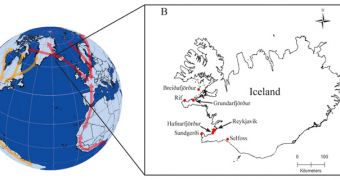A group of investigators from the US Geological Survey (USGS) determined in a new study that the dangerous avian flu virus can use a passageway in the North Atlantic to easily move from Europe to the United States and Canada. Most often, the virus uses birds that stop in Iceland during their migrations.
Discovering how viral agents spread from one continent to the next is a very important part of being able to prevent the global spread of dangerous viruses. The North Atlantic route was thus far unknown to researchers, USGS scientists report in the March 19 issue of the open-access, peer-reviewed scientific journal PLoS ONE. The paper is already available online.
Working together with colleagues in Iceland, the US team was able to discover the avian flu virus in a variety of bird populations using the North Atlantic island as a way station on their flights from Europe to North America and vice-versa. Another important route the virus uses to enter the Americas is the North Pacific, the team adds.
The most concerning aspect of the new study is that it highlights the mingling of bird species from several continents in the same area. In addition to making it easier for the virus to spread to healthy birds, this mixing patterns also enables the pathogen to evolve new strains that are potentially more lethal and more resistant to antibiotics.
“None of the avian flu viruses found in our study are considered harmful to humans. However, the results suggest that Iceland is an important location for the study of avian flu and is worthy of special attention and monitoring,” explains the lead author of the study, USGS investigator Robert Dusek.
The new research was carried out on avian flu virus samples collected from gulls and waterfowl in southwest and west Iceland, in the autumns of 2010 and 2011. Scientists then studied the genomes of all retrieved viruses and found some that originated in North America and some that came from Eurasia. Mixes between American and Eurasian viruses were also discovered.
“For the first time, avian influenza viruses from both Eurasia and North America were documented at the same location and time. Viruses are continually evolving, and this mixing of viral strains sets the stage for new types of avian flu to develop,” adds the principal investigator on the research, study coauthor Jeffrey Hall (USGS).
Researchers at the J. Craig Venter Institute, the University of Minnesota, the Snaefellsnes Research Center at the University of Iceland, and the Southwest Iceland Nature Research Institute all contributed to this study.

 14 DAY TRIAL //
14 DAY TRIAL //